Survival Fishing Trotlines. (With Pictures and Examples.)
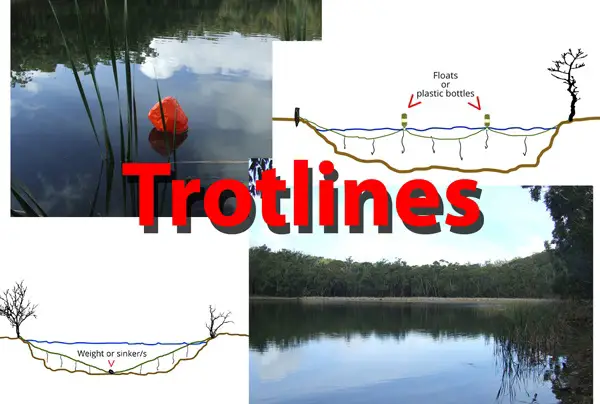
A fishing trotline is a mainline with multiple smaller dropper lines attached to it. The dropper has a hook attached to it. Survival fishing trotlines are a good tool to use and a useful skill to implement.
As the fish will generally hook them-selves and you can leave it unattended for long periods of time. You can do other bushcraft skills in between checking it. This passive fishing, combined with multiple hooks on the trotline, make it effective for acquiring food.
The trotline is versatile. There are a dozen different combinations of setting up the trotline with floats, sinkers (Fishing weights.) and attachment points.
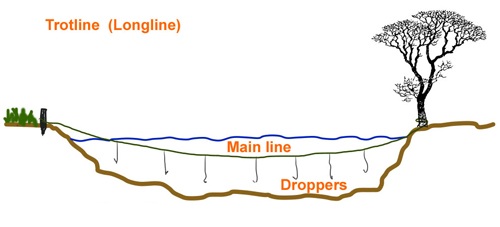
A trotline can be suspended on the water surface, midway in the water column or deep down on the bottom of the lake, sea or river. It can be set so it spans across rivers, lakes, ponds or streams. Or it can be used to run along parallel to the bank, or so it runs out from a lake or sea shore.
Different names.
The trotline is also known as a longline, nightline or setline in different parts of the world.
Another version is the dropline. The dropline can have the main line suspended vertically by a float and can also be termed a jugline.
The secondary shorter lines attached to the main line of a trotline are also called droppers, droplines, snoods, branch line or leaders.
Even in different regions of the same country can have various names for the lines.
Commercial fisherman also have their own lingo, so it can be confusing with all the different terms and names. I will use a few terms interchangeably throughout this article and it may or may not be correct for your location, so bear with me.
Regardless of the names, the fish don’t seem to mind what we call the lines.
The survival fishing trotline set up and variations.
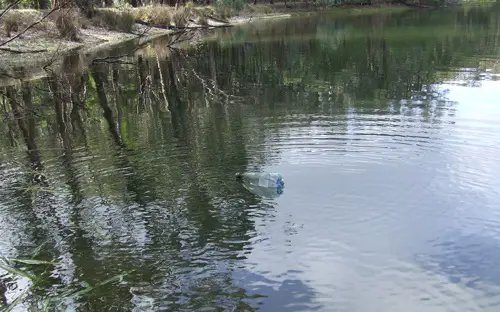
The trotline can be setup a number of ways. A combination of stakes / anchor points, floats and sinkers, (Fishing weights.) can be used to suspend or anchor the longline.
How it is set up will depend on resources, fish species and environment.
Most trotline arrangements will have positive and negative points with each one. If we are talking about wilderness survival, then we probably won’t have unlimited, fishing line, hooks and floats, etc., available. We will have to improvise and probably compromise on the setup, length and amount of baited hooks.
Here are some different set ups and variations of the trotline system:
Basic trotline tethered.
A simple trotline secured between two points, (With no weights or floats on the main line.) is tied close to the water’s edge to trees, rocks, logs. Or secured with a stake hammered into the ground.
The amount of slack line between the two end points will depend on the depth of water, dropper length and fish species.
For fish that feed close to the top of the water column, a taut line might be best. If the fish species feeds at night close to the surface, you might tighten the main line during the night. So the droppers are closer to the water surface.
Alternatively during the day, you might slacken of the trotline, so a “U” is made from the line between the tie off points. Covering the deeper waters.
The depth of the line can also be roughly adjusted to accommodate to the fishes comfort and feeding levels in hot and cold water temperatures.
Trotline with weights.
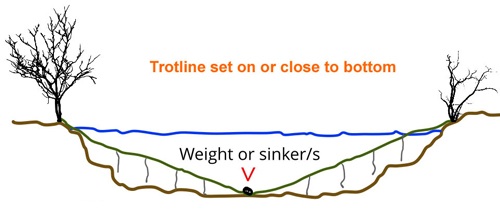
A trotline secured between two points and with a weight or several weights, can keep the baits close to the bottom.
This can stop the line and baits from being pushed to the water surface when the rivers currents or tide is strong. For targeting bottom feeding fish like catfish, this can be an advantage.
For deeper waters, using one heavy weight in the middle of the trotline, also helps fish at different depths.
As a V or U type shape is made with the main line, the higher dropper’s fish at various levels. This can be an advantage to cover different feeding depths for different fish species or thermoclines.
The weight of the fishing sinkers can become an issue for backpacking. So using natural items like rocks, bone, waterlogged or dense types of woods can be used for a sinker.
Rubbish found, like cans or plastic bottles can also be filled with dirt or rocks and used for weights.
One disadvantage with the droppers close to the bottom of the lake or river, is that they can easily snag on weed, logs and debris being pushed by the river flow. They can be harder to retrieve with the weight, or hooks snagging on the bottom.
Trotline with floats in between.
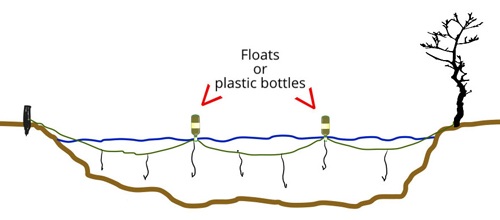
A trotline (Tethered at the ends.) with a float or several floats in between, can be useful for fishing high in the water column. Ideal for fish that feed close to the surface. Or it can help keep the hooks from snagging the bottom or weeds.
Trotline with floats and weights, un-tethered.
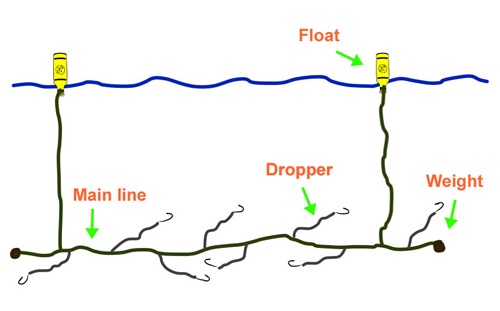
The trotline with floats and weights at each end, can be useful for placing the baits close to the bottom, targeting certain fish species, such as catfish. If there are no trees, submerged logs or ground to stake the line, this setup may be an option.
The drawback is setting it out and retrieving the setup. The wind may blow it around or a big fish can tow it.
Trotlines set with one stake and one weight.
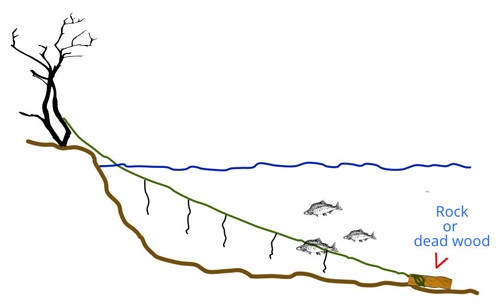
A line set with a heavy weight at one end and tied at the other, can be used to fish different depths. It is also useful if you cannot secure the line to the other end.
Some drawbacks of this fishing setup is that the end weight can be awkward to put it out far enough to span a good fishing area.
Alternatively you may put it sideways / parallel along the bank. Or diagonally along a river or bend in the river.
Retrieving the set without it snagging can also be an issue. Another negative is that a larger fish may move the line around and get snagged.
Trotline set with one float and one stake.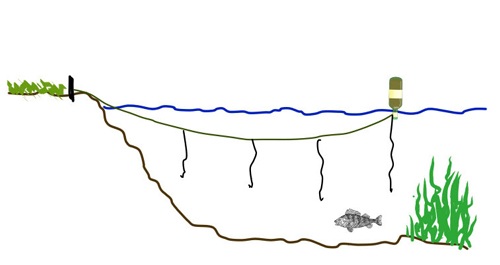
An advantage of this system, is you do not have to try to get around the other side of the river bank or pond. With one end of the line tied, you can fill up a plastic bottle with a little bit of water (Or dirt.) and throw it out into the water.
On windy days that are blowing offshore, you can feed unlimited amounts of line out, hence drifting and covering a wide fishing area. The wave or wind action from the floats can also give the bait more movement.
Weedy lakes or rocky bottoms that contain a lot of snags, may benefit from this set up.
One negative of this system like the other un-tethered rigs, is that bigger fish can swim and tow the main line into snags, as only one end of the line is secure. The wind and currents can also force it into the bank or snags.
Another drawback is you have to find or improvise a float of sorts. (Like a plastic bottle or dry bag.) Depending on the snags around and weather conditions, it may have to be checked more often than another trotline setup.
Saltwater or marsh trotline.
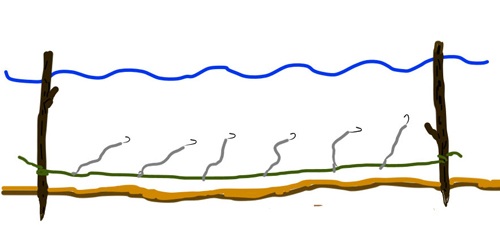
This trotline is staked out in the sand during low tide, where it can be set up easier. The fish come in at high tide to feed and hopefully take the bait. The line is then checked again when the tide is out for easier access.
As the tide can wash the sand away easy, the stake has to be driven into the sand / ground fairly deep. Large rocks can also be used as anchor points at the end of the trotline.
Michael McQuilton from MCQ Bushcraft has an excellent YouTube video on Bushcraft Coastal Trotline Fishing for using the trotline for saltwater fishing. (His bushcraft videos are great and are easy to watch.)
This set up can also be used in shallow swamps, wetlands or marsh areas, flooded plains with no natural anchor points, like trees, etc.
Fishing jugline.
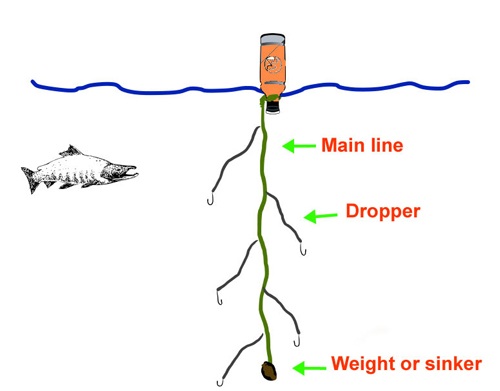
A jugline can be good for deep waters, drop-offs, fishing vertical structures and covering different feeding depths for fish. It also can move the bait with the wind, river flow and currents, giving the bait movement and covering more area.
One drawback for wilderness fishing, is you may not have access to place it out in deep enough waters, or to retrieve it. A boat or raft probably won’t be available.
You could use it in smaller ponds (But deep.) and can push out the jugline and retrieve it with a long forked stick.
You can also deliberately let it work across smaller ponds or lakes by the winds. But can be hard to retrieve it when fish take it, or the wind changes.
Another option, although not really feasible in a lot of situations and could be dangerous, is to put it out and retrieve it by swimming.
Icy cold water, strong tides, competency and fitness levels when swimming, unforeseen snags and possible alligators and crocs in some warmer waters are a few things to consider. Probably not great in a wilderness survival situation.
Energy or calories used putting the line out this way, also have to be weighed against the potential food (Calories.) it brings in.
Jugline secured to the bank.
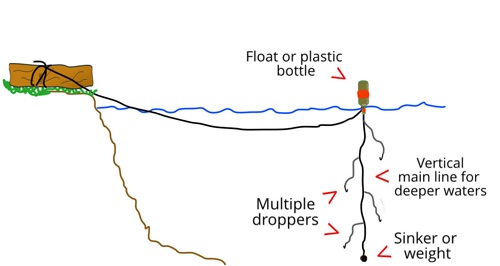
One variation of the jugline is to secure to the bank with a line. The advantage is that it can easily be retrieved and doesn’t have to be attached to both sides of the bank.
The disadvantages, like the other juglines and rigs, is the wind direction and bigger fish can drag it around.
What are the negatives of trotlines and juglines?
The trotline is only effective if the fish are biting and take the bait. In extreme cold or hot water temperatures, compared to the normal fish’s habitat and comfort range, the fish may not bite.
Flood waters, low water levels, rivers not flowing or little oxygen in the water, can also inhibit the fish’s appetite. Food available, predators, seasonal migration and breeding can interfere with the fish biting or even being in the area.
Because of the above points, a gill net might be a better option for long term wilderness survival.
However, the gill net has its own drawbacks as well. Like it’s indiscriminately catch rate, ethical reasons and is illegal in a lot of countries and states. But for a pure survival situation, a gill net is generally more effective than a trotline. That being said, survival fishing trotlines are a good fishing tool and takes up less space than a gill net.
The trotline has a lot advantages over limb lines, hand held fishing rods and other methods of fishing, because of its multiple hooks and area covered.
Length of the trotline.
A longer trotline (Or several shorter trotlines in different locations.) will generally be preferred to a shorter one. As you can have more baits presented to fish, and hence potentially more chance of catching fish.
A smaller body of water and how much line carried, will limit the length of trotline.
Practical versus prepared fishing kits.
The amount of line carried in your fishing survival kit has to have a practical element to it as well.
If you practice your bushcraft skills in desert environments or near very small creeks, there is no use carrying big heavy spools of paracord, fishing line or bank line and 200 hooks and swivels. (Although the cordage can be used for other uses.)
Here are three options for the kits:
For areas with minimal fishing opportunities a small Altoids tin survival kit with a dozen hooks or so and some light fishing line might do. This might be part of your normal survival kit or EDC kit. (Every Day Carry.) For the main line, bankline or paracord can be used. Paracord can also be stripped down into smaller strands for the droppers.
When you go near bigger water ways or fishing spots, a medium size dedicated survival fishing / trotline kit might be put in your pack. But there is a balance of being prepared, but also being realistic on carrying extra weight and bulk in your pack when hiking and the terrain you are in, or could be in.
You might have a separate bigger and elaborate trotline fishing kit stored in your vehicle as well. This one might have large floats and multiple fishing line poundage’s and hook sizes. (More a prepper or long term trotline fishing kit.)
These three options of having a smaller fishing kit, (In your normal survival kit.) a medium size kit and a large trotline kit can give you more choices for the environment you are going to be in. You might have all three set up.
Length of the droppers.
The length of the leaders or droppers will depend on the depth of water, fishing line or cordage type, line available, size and type of fish species, etc. As a rough guideline, the droppers can be about 40cm long. (Roughly 15”.)
For larger bodies of water the dropper might be around a meter long. (About 39”.) Too long of length and the dropper can get tangled to other lines or snags. Too short and they may not present the bait naturally enough.
For trotlines set close to the bottom, shorter droppers may be preferred as less chance of hooking underwater snags and structure.
How far apart for the droppers?
The droppers or leaders should be set apart so if one dropper catches a fish, it will not tangle the closet dropper to it. Otherwise you have eliminated a hook, which could be another fish caught and potential calories.
Another factor to consider is that some fish will be attracted to another fish being hooked, therefore the droppers might be set reasonable close. Other fish species can shy away from the commotion, so droppers might be set a little bit further apart.
Once again the setup will depend on your resources, species and environment.
Where to place the trotline?
Fish where the fish are, sounds obvious, but it is worth thinking about in depth. Fish are like humans in a sense, which they have basic needs of food, shelter from predators, breeding, comfort, etc.
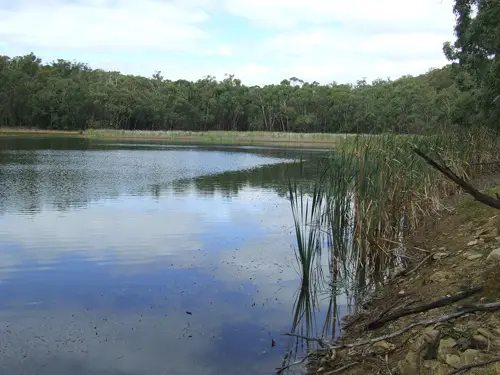
Structure will generally provide a good place to set the trotline close to it. As structure helps hide fish from other predators. Structure is also an ideal place for food like, aquatic insects, crustacean’s and baitfish.
Submerged trees, rocks, deep drop offs, channels and weed beds provide food and cover. Incoming and outgoing creeks and rivers, overhanging branches are worth checking out.
While there are 101 other factors for can affect the fish biting, three basic questions can help narrow a spot quicker. 1. Where are the fish living now? 2. What location do they get their food from? 3. What are the fish eating?
Local knowledge of the fish species helps. But fishing is fishing and there are no guarantees.
Energy used. Risk versus reward.
As well as setting up the trotline in a hopefully productive area to catch some fish. Another aspect to consider is energy used (Or calories used.) to get to the hot spot, for the return of the fish caught. (Potential calories.)
Weather conditions, fitness levels, resources will have to be considered, compared to the trade-off of possibly catching more fish. The chance of encountering dangerous wildlife, possible injuries, or getting wet and cold, also have to be weighed up, when placing the trotline. Especially if it is a real emergency long term survival situation.
Carrying the setup.
With all the sharp hooks attached to the mainline, it can be a pain (Pun intended.) to carry safely. Also the line and droppers can get tangled easy.
The safest way is to have the hooks in a separate container or bag and not already attached to the droppers and main line. However, this is also the slowest way of setting it up as you have to tie them on.
Another option is to have the hooks tied to the droppers. (The droppers are not attached to the mainline.) The individual droppers can be wrapped around a spool on a separate pipe or board.
Some people have the whole longline setup and rolled around some dowel, spool, PVC pipe, or pool noodle. The hooks are set into corks or into the pool noodle (Or tape over the hooks.) so the hooks aren’t dangerously waiving about. However the trotline all set up, can be bulkier to carry.
How many hooks? Play the odds.
Basically the more hooks presented in the water, the more chance of catching a fish.
Obviously if there are no fish in the area, the wrong season, or you have the longline set high in the water column, when the fish are on the bottom, etc. will affect your catch rate. Generally though, the more baits in the water the better.
Depending on your resources and location, you might have 6, 10 hooks on the trotline or up to 30 hooks in the set. If you have limited fish hooks, you might be able to make some additional gorge hooks or improvised hooks.
Multiple longline sets with 50 or a hundred hooks increase your odds dramatically. But the bulk of the gear and effort to set them up and check them regularly has to be balanced with fish caught.
Hook size.
Hook size will depend on where you mainly camp or travel and fish species size. There is no sense carrying shark size (We are going to need a bigger boat.) hooks, when you mainly hike around small streams containing small pan size fish.
While a small hook may catch a big fish, a larger hook is harder to catch a smaller fish. The best bet is to carry a reasonable range of hook sizes, but with a hook size preference for your area you frequent. Or areas that you may get stranded, such as traveling in remote areas.
Treble hooks are effective but will take more room in the fishing kit and can be easier to tangle up. Treble hooks also have the advantage of jagging the fish as well, but can be more hazardous to use.
What fishing bait?
If you look closely around the water edge and in the water, you can generally find what the fish could be eating. Lift a few rocks, logs and look in the weeds to find out.
Most times the insects, crustaceans, worms, bait fish, etc., that are in the area, will be the best and freshest bait to use. Some fish will eat anything anytime, other species are fussy or feed intermittently.
Live bait will generally outperform dead bait.
Dead bait (Fresher, in the scheme of things.) will usually perform better than old dead bait.
If you are lucky enough to get hold of a fish, open its stomach contents and see what it has been eating. It is always interesting to see what the fish has been gorging on. (A lot of times I have reused the bait from the fish’s stomach.)
The tried and tested worms for freshwater fish is hard to go past. Crickets, grasshoppers, grubs, mudeyes, (Dragonfly larvae.) frogs, snails, slugs, leeches, crawdads (Yabbies or crawfish.) and baitfish are just a small example of what you could use.
Fish offal and bits can be used for bait as well. Small birds, mice, fish eggs, even berries, mammal offal or meat can be used depending on fish species.
For saltwater fishing, the wide range of fish species are more open to a wider range of baits. Like crabs and shellfish.
Maggots can be an effective bait for some fish.
It might seem unrefined, but a rotten animal carcass on a branch overhanging the water can attract baitfish (For netting.) or bigger fish. This could be placed near your trotline or limb line. Taking into account wind, water flow, etc. Or it could be put in a bag and used for burley or chum, near the fishing line.
If there is no natural bait around, an improvised lure can be made.
A strip of paracord, cotton strands, feathers, silver foil, chewing gum wrapper, silver side of a potato crisp packet, small piece of a Mylar survival blanket, plant material, shiny zips, fur, hair, small pieces of tin, all can be used to make a lure or fly.
If you are short of bait, you might be able to combine an artificial fly with some small bits of natural bait like, a third of a worm. The man made baits are best used with some movement, vibration, smell or flash to attract the fish. The natural wave action of a trotline with a float, or wind can make the bait move and seem more alive.
A bit of a side story, once when fly fishing, I was Polaroiding on a high vantage point for trout. A dandy lion fairy seed blew across the water and about a 1 ½ pound rainbow trout swam chasing it below the surface. The trout chased it a fair way, as the fairy seed was quickly blown across the lake. Sorry, I am rambling on. But the point is, movement can attract a fish by itself.
Fishing line poundage.
Para cord, strong fishing line and bank line can all be used for the main line. The main line should be stronger than the droppers. So if a fish breaks you off, or a snag, you don’t lose the whole trotline set. (Tarred bank line is more resistant to rot so ideal if left in the water for prolonged periods left in the water.)
For the droppers or leaders, the poundage of the line will depend on the general size of the fish about. Personal preference, quality of the line, species of fish also come into play.
If the fish have sharp teeth, course scales, spines, etc., they might cut the line easily. So a stronger dropper would be used.
Too thick of diameter line and it is harder to catch finicky fish. Too thin of line and you have more chance of the fish breaking the line, especially if left overnight or for a long time.
If you hike around small streams, maybe 5lb, 8lb or 10lb fishing line would probably do for the droppers. Local knowledge is key here of what species and typical sizes are about. If in doubt go for a stronger poundage.
For bigger water ways and bigger fish, or even saltwater locations, then you might be looking at 12lb, 20lb, 30lb or even 50lb line. It is a personal preference again and depends on species and general size.
Thicker line will obviously be stronger, but the diameter will also take more room up on your spool or kit. Thinner fishing line can allow more length to be stored on a spool, but will be weaker.
Natural cordage of course can be made. Materials like certain plant fibers and bark can be made into line. However, it takes a lot of time resources and effort, especially for a long trotline. Strength is also an issue with making natural cordage.
Wire trace leaders.
Fish species with sharp teeth or sharp gill rakers can cut fishing line easily. Especially when left on the line for some time, so wire trace may be required for some fish species. One drawback is carrying multiple wire trace droppers and connections is the weight and bulk.
The advantage of wire traces they can also be used for animal snares and traps as well.
Fishing sinkers or weight.
For some fish species, a weight on the whole main line or fishing sinkers on individual droppers may help get the bait down to target the fish.
Weights can also keep the bait away from the surface water flow, were sticks and leaves floating by can get snagged on the hooks. The hook points can become ineffective if clogged with debris. As discussed in the, trotline with weights setup, fishing sinkers are heavy and a drawback for hiking or a survival fishing kit. So improvised sinkers can be made from; rocks, bone, heavy dense or waterlogged wood, plastic bottle filled with dirt, etc.
Floats.
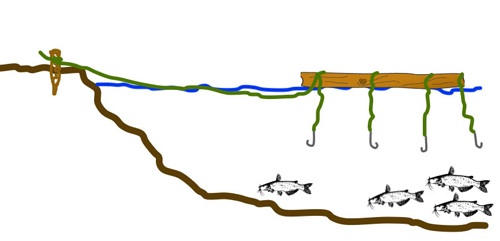
While floats don’t weigh much, the bigger floats can be bulky, especially floats big enough to support a trotline set up or long jug line. Generally dedicated fishing buoys for the trotline aren’t practical to carry, but could be stored in a vehicle fishing kit.
Balloons take up little space in a backwoods fishing kit, but are generally not durable for prolonged fishing.
Alternatively some improvised floats could be plastic water bottles, using buoyant wood like bamboo, black poplar, water bladder, an animal stomach, a dry bag, parts of a foam hiking mat, buoyant rubbish found like polystyrene, flip-flops (Thongs.) etc., can be used.
A glass bottle can also be used, just fashion a cork like plug out a branch.
Some of the above floats are better suited for a personal fishing line and not intended to take the weight of a 30 hook set, paracord trotline. However some floats can work with a bit of thought.
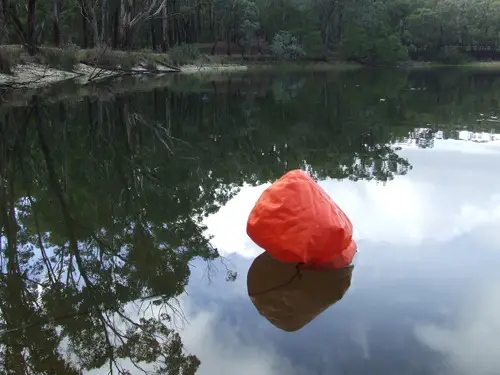
Fishing swivels.
For smaller fish, swivels may not be required on the dropper line. But if the trotline is left overnight or with bigger fish, swivels are a good idea. As bigger fish can twist the line and cut it off. Swivels don’t weigh much, but take more time to set up on a trotline. Both methods have worked, with or without swivels.
Some setups use the swivel eyelet directly threaded on the main line. The swivel can slip up and down the main line, so knots can be put on the main line to stop the swivels sliding too far.
Be aware that any knots can directly weaken the line. Other rigs have a short piece of dropper, then the swivel, then another longer piece of dropper. (Basically the dropper has a swivel tied in about a quarter of the total length of it.)
The dangers of setting up a trotline.
Anytime you are beside a body of water, there can be dangers, like slipping in icy cold waters, dangerous wildlife near the water’s edge.
In warmer climates, crocodiles, alligators, etc. could be a real concern in your area. Snakes around the bank looking for frogs, or even mosquitoes can also be an issue.
Even getting a hook stuck in your hand, can cause a lot of serious complications, like an infection.
Legalities.
Check local and state laws for the legalities of fishing with the trotline. Because it is an effective method of fishing, it is illegal or restricted in a lot of areas.
Summary of the survival fishing trotline.
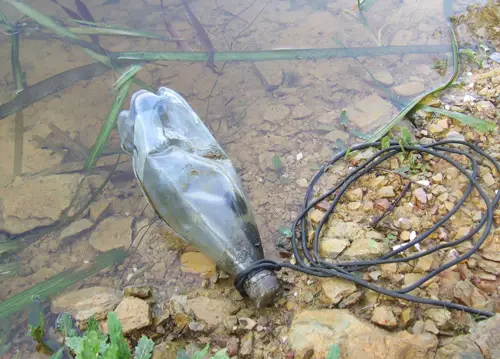
For a survival situation, a trotline has a lot to offer. It can be set up to help acquire food for minimal effort. The risk / reward of energy expended (Using calories.) versus the probabilities of catching fish (Calories in when consumed.) are good.
Once setup, the trotline can help fish passively and the person can save energy or do other bushcraft skills or chores. For short term survival, food is low on the priorities list. But for long term survival, food grows in importance. A good survival fishing trotline setup can increase your catch rate and put food on the table.
